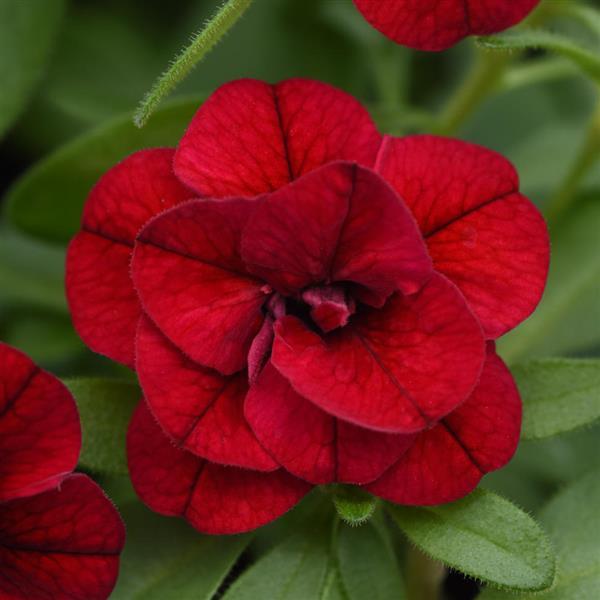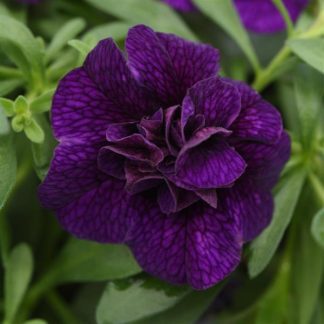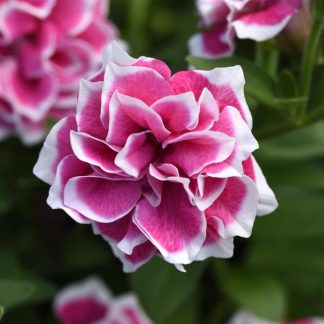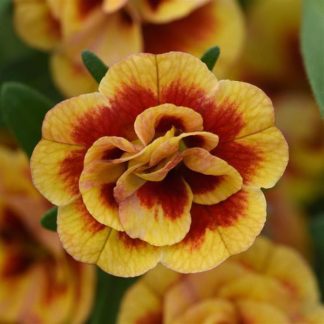Description
Calibrachoa ‘Double Red’: A Friendly Guide to Bold, Endless Color
Welcome to the World of Double Red
Picture a cascade of small, velvety red blooms tumbling out of a hanging basket all summer long. That is the magic of Calibrachoa ‘Double Red’. We love this plant because it mixes the charm of miniature petunias with the stamina of a champion marathon runner. In other words, you get nonstop color, day after day, from spring’s first warm breeze until frost finally calls time-out.
But most of all, ‘Double Red’ is easy. You do not need a huge yard, fancy tools, or hours of spare time. Instead of fussing, you can simply plant it, water it, and watch it glow. Let’s dive in together and explore how this vibrant beauty fits into your garden life.
Description
A Flash of Crimson Delight
Calibrachoa ‘Double Red’ belongs to a family often called “million bells.” Each blossom looks like a tiny rose, complete with layers of ruffled petals. The color is a deep, true red—rich and vivid—so it stands out against green leaves and mixes well with softer hues around it. Every flower measures about one inch wide, yet the plant produces hundreds at once. The effect is like a living firework frozen in bloom.
Compact but Generous
A mature plant spreads 18–24 inches and trails down 10–14 inches. It forms a soft mound first, then spills over the edges of containers, raised beds, or rock walls. Because stems stay flexible, you can train them to drape from window boxes, weave through railing planters, or creep along the front of a garden bed.
Leaf and Stem Details
Leaves are smooth, narrow, and evergreen in mild climates. They form a tight backdrop that lets the red petals shine. Stems are thin but sturdy, branching freely without pinching. After more than a few weeks of growth, you get a lush, cascading curtain that looks full but never heavy.
Blooming Schedule
We enjoy flowers from early May right through October in most regions. In warm zones, blooms may begin even earlier. They open in morning light, shrug off light rain, and close only when daylight fades. Because each flower self-cleans as it ages, new buds pop up to replace spent blooms without any extra work from you.
Perfect Places to Show Off
- Hanging baskets—One plant can fill a 12-inch basket by itself.
- Mixed containers—Pair it with lime-green coleus, white verbena, or trailing silver dichondra for contrast.
- Garden edges—Let stems spill over stone borders to soften hard lines.
- Vertical gardens—Tuck starters into wall pockets for a living red tapestry.
Design Tips We Love
- Use ‘Double Red’ as a bold accent in patriotic red-white-blue summer pots.
- Combine with yellow calibrachoa cousins for a spicy “hot colors” theme.
- Thread stems through a small trellis in tabletop planters for a fairy-garden arch.
Friendly to Pollinators
Though double blooms hide nectar a bit, bees still visit on warm afternoons. Hummingbirds may hover, too, drawn by the bright color and trumpet shape.
How to Care for Calibrachoa ‘Double Red’
Light: Sunshine Is Fuel
Give your plant at least six hours of direct sun daily. Morning sun plus dappled afternoon light works well in hot regions. Too little sun leads to fewer flowers and lanky stems.
Soil and Potting Mix
- Drainage first. Roots hate sitting in water. Choose a high-quality potting mix with perlite or fine bark for good airflow.
- pH sweet spot. Aim for slightly acidic to neutral soil (pH 5.5–6.5). This keeps nutrients available.
- Container size. A single plant thrives in a 10- to 12-inch pot. Larger pots allow companions but need more soil moisture management.
Watering: Steady and Mild
Calibrachoa prefers even moisture, not constant wetness. Stick your finger into the soil. If the top inch feels dry, it is time to water. Let excess water run out of drainage holes. During peak summer heat, baskets may need daily drinks. In cooler spells, water every two to three days instead.
Feeding: Small Meals, Big Results
Instead of heavy doses, offer a balanced, water-soluble fertilizer at half strength every week. In other words, feed lightly but often. This steady stream of nutrients powers continuous bloom without causing leafy overgrowth.
Pruning and Grooming
You do not have to deadhead, because spent blooms drop on their own. However, after more than eight weeks of nonstop flowering, stems can stretch. Give the plant a “haircut” by trimming back the longest runners by one-third. Within ten days, new shoots appear, packed with fresh buds. We like to time this trim right before a brief summer trip—returning home to a rejuvenated display feels great.
Temperature and Humidity
Calibrachoa shines in 55–75 °F daytime temperatures. It tolerates short dips to 40 °F but pouts below that. In steamy regions, ensure good air circulation to prevent mildew. If you garden where nights stay above 80 °F, place baskets where they get a cooling evening breeze.
Pest and Disease Watch
- Aphids—Spray with a simple blast of water or use insecticidal soap.
- Spider mites—Rinse leaves weekly and keep humidity moderate.
- Root rot—Avoid overwatering and maintain sharp drainage.
- Iron deficiency—Leaves turn yellow but veins stay green. Fix by lowering soil pH with a dose of chelated iron and assuring regular feeding.
Propagation Made Simple
Calibrachoa hybrids like ‘Double Red’ rarely grow true from seed, so we rely on cuttings. Follow these steps:
- Snip 3-inch non-flowering tips in late spring.
- Remove lower leaves and dip ends in rooting powder.
- Stick cuttings into damp, sterile mix.
- Cover with a clear dome to hold humidity and place under bright, indirect light.
Roots form in ten to fourteen days. Transplant to small pots, keep moist, and feed lightly until they fill out.
Overwintering Ideas
In zones colder than USDA 9, treat Calibrachoa as an annual. If you hate to let it go, root a few cuttings in early fall and keep them under grow lights indoors. After more than three months of winter rest, your young plants will be ready to return outside when frost passes.
Sustainable Habits
- Reuse potting mix by refreshing with compost and perlite between seasons.
- Collect runoff water in trays to measure and adjust future watering.
- Compost spent plants at season’s end to feed next year’s garden beds.
Troubleshooting Cheat Sheet
| Problem | Likely Cause | Quick Fix |
|---|---|---|
| Few flowers | Too little light, overfertilizing | Move to sunnier spot, switch to weekly half-strength feed |
| Yellow leaves with green veins | High pH, iron lock-out | Add chelated iron, check soil acidity |
| Wilted foliage but wet soil | Root rot | Allow soil to dry, improve drainage, trim back |
| Sticky residue on leaves | Aphids | Rinse with water, apply insecticidal soap |
Keeping Blooms Coming—Our Favorite Routine
- Morning check: Feel soil, water if dry.
- Weekly feed: Mix fertilizer at half strength, drench soil until it drains.
- Bi-weekly rinse: Spray foliage to clear dust and small pests.
- Monthly trim: Lightly shear longest stems to spark fresh growth.
Follow this cycle, and your ‘Double Red’ will reward you with a river of color.
Bringing Calibrachoa ‘Double Red’ Into Your Life
Now you know what makes this plant special, how it grows, and how easy it is to keep happy. All that is left is to invite it into your space. Gather a bright pot, fill it with airy mix, tuck in a healthy start, and set it where you will see it every day. We promise the rich red petals will greet you like cheerful friends each morning.




